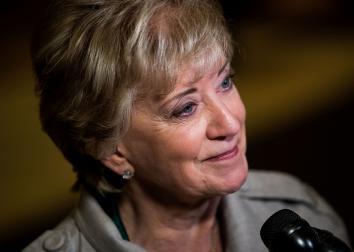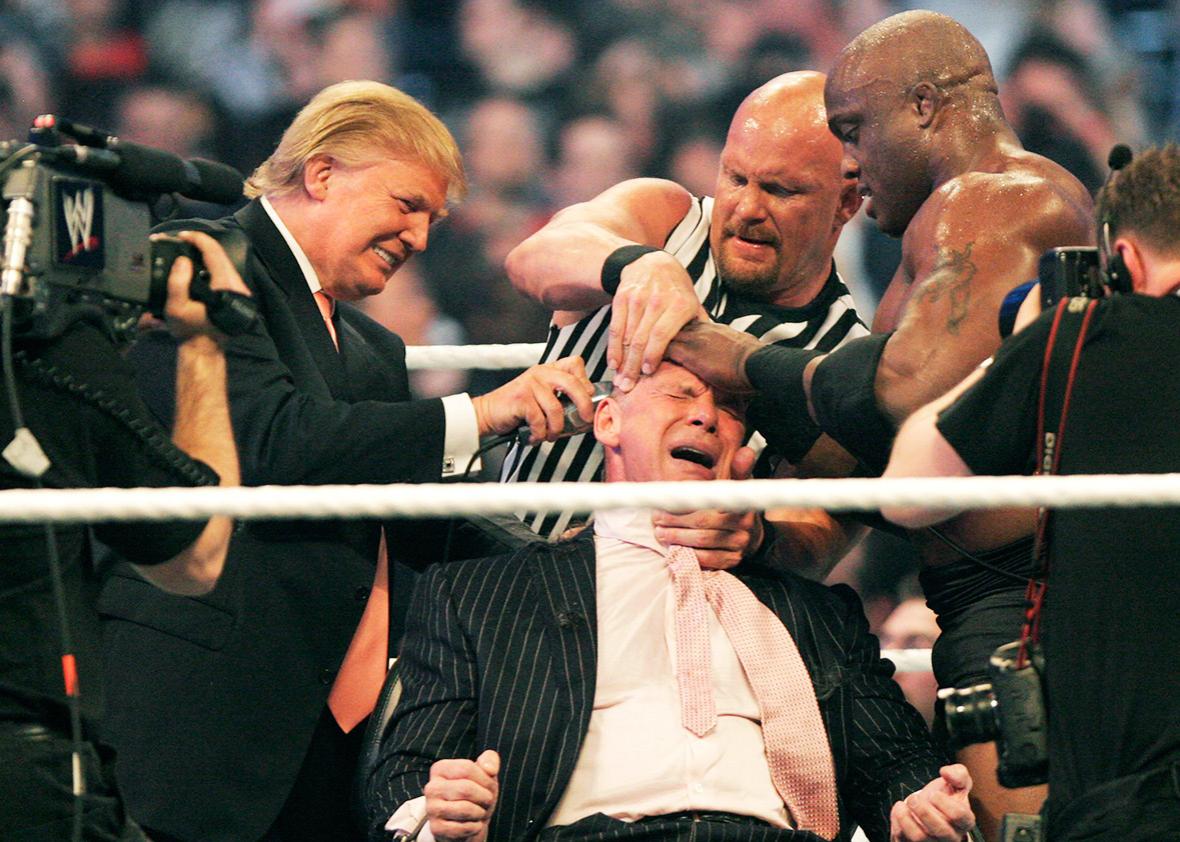Linda McMahon, President-elect Donald Trump’s pick to head the Small Business Administration, will carry several distinctions should she be confirmed. McMahon, the former president and CEO of World Wrestling Entertainment, who has also appeared at pro wrestling events as a fictionalized version of herself, will be the first Cabinet-level official who has received the Stone Cold Stunner from Steve Austin. She will be the first to have been Tombstone Piledriven by the Demon Kane. And she will be the first to have kicked WWE announcer Jim Ross in the crotch.
It may be surreal to see Trump offer a professional wrestling magnate a role in his administration, but it’s not surprising. After all, the president-elect is in the WWE Hall of Fame, has hosted two WrestleManias at Trump properties, and even headlined one in 2007, resulting in that photo you may have seen of Trump helping to shave the head of Vince McMahon, Linda’s husband and the WWE founder, in the middle of the ring.
Like Linda McMahon, Donald Trump played an exaggerated version of himself in WWE programming. You could argue he’s played a character for much of his professional life, particularly during (and since) the 2016 presidential campaign—with no regard for the consequences. Specifically, Trump has acted like what’s known in wrestling as the “heel”: the villain who breaks the rules and insults his opponents to get “heat”—a reaction—from the audience. The best heels make their wrestling promotions money: The audience pays to see them eventually get their comeuppance at the hands of the baby-faced hero (or simply “face”).
Trump is a textbook heel. In fact, almost everything he’s done since announcing his candidacy in June 2015 has a pro-wrestling analogue, from his attacks on Mexicans and women to his Islamophobic attitude toward Muslims. Like a heel, he’s broken rules of political discourse and conduct, then accused his opponents of doing the same thing. Most notably, he complained of a system that was rigged against him until he won the ultimate prize, like a heel that complains about a referee’s bias until the same referee doesn’t catch him cheating. At no time during the campaign or the transition has Trump been playing by the rules of politics: He’s been playing—and winning—by the rules of pro wrestling.
Trump’s entrance into the world of wrestling, and his acquaintance with the McMahons, began as the type of low-risk, high-reward business opportunity that he’s relied on throughout his business career: Hosting 1988’s WrestleMania IV at Trump Plaza was an easy, flashy way to get not-quite-high rollers to bring their wives and kids to Atlantic City, New Jersey, for the weekend and drop cash at the casino. The event returned to Trump Plaza in 1989.
What kept Trump coming back—being interviewed by wrestler-turned-politician Jesse Ventura at WrestleMania in 2004, participating in a “Battle of the Billionaires” against McMahon in 2007, “buying” the WWE’s Monday Night Raw in 2009? It’s arguably his relationship with Vince McMahon, to whom he’s led an uncannily similar life. Both were born to successful regional businessmen who made millions in their fields: Fred Trump built properties in the outer boroughs of New York while Vince McMahon Sr. promoted wrestling in the Northeast and mid-Atlantic.
When Donald and Vince Jr. took over their family businesses, they moved beyond their parochial origins (Trump set his sights on Manhattan, while Vince Jr. outmaneuvered competitors across the country) to turn their companies into national powerhouses and make their brands iconic: Donald Trump became a symbol of ’80s wealth, while McMahon’s greatest creation, Hulk Hogan, became a symbol of Reagan-era pop culture.
The ’90s weren’t kind to either Trump or McMahon. The former had a very public divorce and saw his casino business collapse, while the latter survived a federal steroid trial only to be nearly put out of business by Ted Turner’s WCW promotion. But despite the dips in their respective fortunes, both Trump and McMahon would be on top—and on the Forbes list—by the end of the decade. In the new millennium, they had matched or exceeded their ’80s business successes, and even shared a catchphrase: Trump issued a terse “you’re fired” to contestants on The Apprentice while an in-character McMahon growled “you’re fired” at his wrestlers.

Drew Angerer/Getty Images
The similarities don’t end there—they both worked with Mike Tyson (in the wrestling ring and the boxing ring, respectively) and tried to compete with the NFL—and it’s clear that Donald Trump and Vince McMahon have worldviews and business approaches shaped by similar experiences. They understand how pro wrestling and its carny traditions can make money off of “marks,” the unsuspecting fans who don’t know (or don’t care) that it’s a con. And more than money, they’ve paradoxically used a staple of low culture—pro wrestling—to find mainstream credibility.
Since going public in 1999, the WWE has become increasingly family (and shareholder-) friendly. After decades in which wrestlers died early deaths due to steroids and drugs, the WWE instituted a stringent wellness policy. They’ve become the picture of a charitable corporate actor, sponsoring an anti-bullying initiative and working with Susan G. Komen, Make-A-Wish, and the Ad Council on a variety of campaigns. WWE programs constantly trumpet how well they’re doing in the ratings and on social media metrics compared to “real” sports, while describing their product as “sports entertainment,” not low-budget, low-culture “pro wrestling.”
Similarly, there’s the theory that the seed of Donald Trump’s decision to finally (actually) run for president in 2016 was planted at the 2011 White House Correspondents’ Dinner, where Trump was roasted by President Obama. “That evening of public abasement, rather than sending Mr. Trump away, accelerated his ferocious efforts to gain stature within the political world,” wrote Maggie Haberman and Alexander Burns in the New York Times, noting his “deep yearning … to be taken seriously.” With just over a month until his inauguration, people laughing at Donald Trump are coming to grips with the fact that he’s going to have the most powerful job in the world. Just as McMahon sought legitimacy by re-casting his fake sport as a global entertainment brand, Trump entered presidential politics to prove that he had to be taken seriously as a public figure.
Coincidentally, Trump’s ascendance will finally give the McMahons the political legitimacy they have not been able to obtain on their own: Linda McMahon unsuccessfully ran for U.S. Senate in Connecticut in 2010 and 2012, spending nearly $100 million of her own money. In both elections, she stressed her credentials as a job creator and political outsider willing to spend her own money and reject political action committee donations, an approach with which Trump would find much more success.
It’s worth noting that McMahon ran away from pro wrestling in her campaign: she hand-waved the hyperviolent, oversexed product WWE had pushed in the late 1990s and early 2000s as “scripted television entertainment” and called on WWE fans to “correct biased and inaccurate media reports.”Meanwhile, Trump spent the entire campaign in full-on heel mode.
Now it turns out that Linda McMahon didn’t need to spend $100 million to gain some power: She and Vince may have just needed to give $5 million to the Trump Foundation (and another $6 million to a super PAC supporting Trump’s run): $4 million in 2007, the year of the Battle of the Billionaires, and $1 million in 2009, when Trump—in storyline—bought and sold WWE’s Monday Night Raw. In the end, Trump and the McMahons did what wrestling promoters have done for a century: counted the money in the back while the marks in the audience watched the spectacle in the ring.
